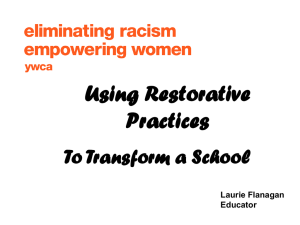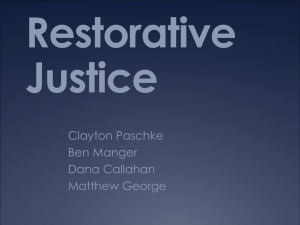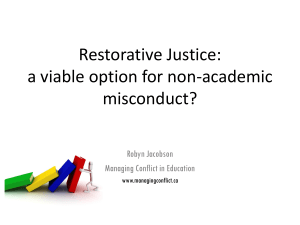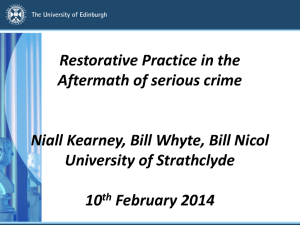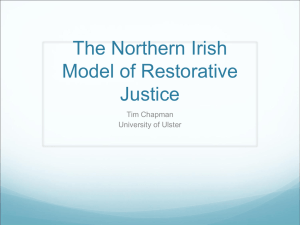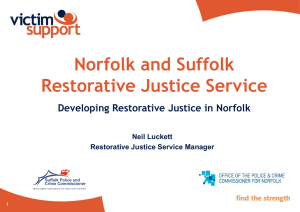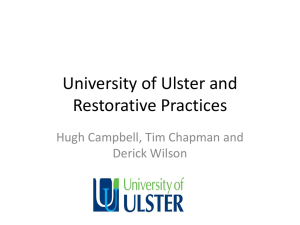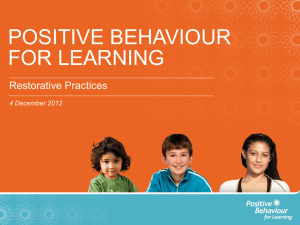RestorativeJustice Floor Meeting Presentation
advertisement
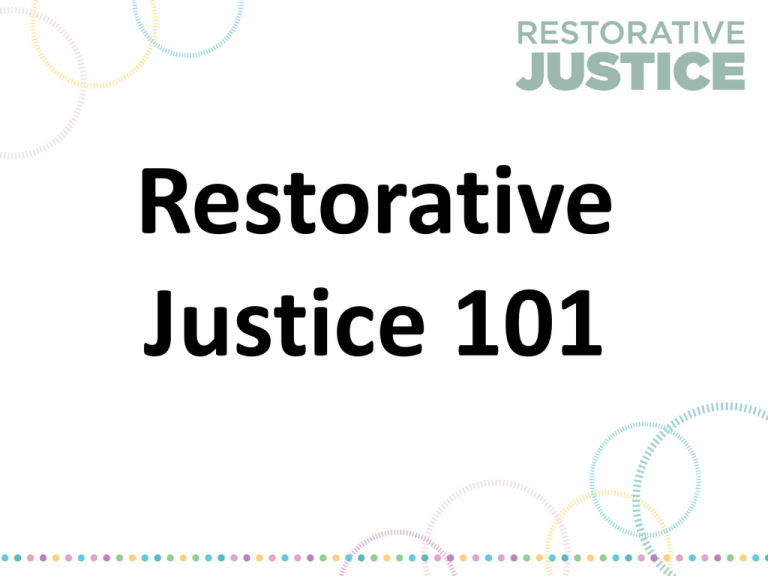
Restorative Justice 101 Conflict Resolution Options When a conflict arises, your mentor has several options available. INFORMAL FORMAL Spectrum of Resolution processes Informed by Social Justice Theory Student Conduct Practice Through a Social Justice Lens , Edited by Jennifer Meyer Schrage , Nancy Geist Giacomini Adjudication Formal Resolution Adjudication Informal Resolution Shuttle Diplomacy Restorative Justice Practices Mediation Facilitated Dialogue Conflict Coaching Debate Dialogue Discussion Which option your mentor chooses will depend on the circumstances of the situation. No one option is going to work for every case, or every resident No Conflict Management ◦ ◦ Recognizing the spectrum of conflict resolution options available to all, MSU has adopted Restorative Justice as the foundational philosophy for conflict resolution and conduct issues on campus. Check out how the ROIAL players imagine RJ working in MSU residence halls. Find the video at: www.reslife.msu.edu/rj/https://apps.reslife.msu.edu/sites/rj/?page_id=9 Or on YouTube at http://www.youtube.com/watch?v=OjW-i9hI_0c&feature=player_embedded A Different Approach Traditional Discipline Asks: • What rules have been broken? • Who did it? • What do they deserve? Howard Zehr, From his Keynote Address to the 12th International Institute for Restorative Practices, October 2009 Restorative Justice Asks: • Who has been hurt? • What are their needs? • Who has the responsibility to make things right to restore relationships? Restorative Justice is central to the way many aboriginal cultures from Native American to Maori resolve conflict and address misconduct. Here in the U.S., Restorative Justice began in the criminal justice system and moved into juvenile justice and school discipline. In addition to its focus on healing the harm rather than focusing on punishment, Restorative Justice is also different because: • It engages all those directly affected by conflict or misconduct—victim, members of the community, supporters—who talk together about what happened and lay out actions necessary to make things right. • Accountability is based on the expectation that the person who caused the harm will complete the steps defined by those affected. • It is based on respect and a sincere desire to heal the harm as much as possible. The Restorative Justice Philosophy offers a variety of tools anyone can use to resolve conflict and address misconduct. Restorative Justice Practices From the IIRP’s Restorative Practices Handbook Page 12 Informal Affective Statements Affective Small Questions Impromptu Conference Formal Restorative Formal Circle Conference Affective questions are at the informal end of the continuum. When You’re in a Conflict Situation try to resolve it by asking these questions: • What Happened? • Who has been affected and how? • How can we make this right? Try using Restorative Justice tools, such as affective questions and statements if you’re experiencing: • • • • • • • • Interpersonal Conflicts Room-mate disputes Staff disagreements Bias incidents Vandalism Assaults Theft Other If you have an issue you can’t resolve on your own, Residence Life staff-members have been trained in Restorative Justice tools from the more formal end of the continuum, such as circles and conferences. If you engage in a Restorative Justice Conference or Circle, keep these points in mind: 1. After the misconduct or conflict happens you will have a conversation with a CLS Res Life staff-member (probably your mentor and/or building director). 2. If staff offer you an opportunity to participate in a Restorative Justice session you will probably have a preconference meeting with the facilitator to help him/her understand the situation and prepare you to participate fully. 3. In the conference or circle, participants will sit in a circle and speak one person at a time, using a talking piece in circle or answering questions in a conference. 4. Every Restorative Justice session is based on respect and desire to make things right. MSU is pioneering the use of Restorative Justice (RJ) philosophy and practice in higher education. The following video offers an explanation and example of how we’ve used RJ for an issue in the halls. Find the video at www.reslife.msu.edu/rj on our home page, on the R: drive under Restorative Justice/RJ Media/RJ avi or /RJ wmv, or on-line in Vimeo at http://vimeo.com/nickzmiller/restorativejustice A Taste of the Restorative Justice Experience 1. Sit in a circle so that every person can see every other person’s face. 2. Using a talking piece, explore the questions on the next slide. 3. Ask each question (one at a time) then pass the talking piece to the person sitting at your right or left. 4. Invite every member of your circle to answer the question when the talking piece comes to him or her. When participants have answered the question, they pass the talking piece to the person on their right. 5. Continue this process until the talking piece has gone all around the circle. Once everyone has had a chance to answer the question, repeat the process, asking the next question. Remember: 1. When a person holds the talking piece he/she has the right to speak without interruption. If you are not holding the talking piece it’s your turn to listen to what your floor members are saying. 2. Everyone has the right to pass the talking piece without comment if they choose not to speak when it comes to them. Circle Questions: • In one word, tell us what you think about restorative justice in general. • Could you use it in your daily life? (Yes or No answers only please.) • What do you take from this RJ experience? Please ask all attendees to answer the following questions to help us strengthen our RJ efforts. Please circle the appropriate response below. 1. Would you like to have more floor interactions in a circle format? 2. Have you used restorative practices prior to this program? If yes, do you believe this approach was effective ? 3. How do you think you can use restorative practices in your life? YES YES YES NO NO NO 4. Would you be interested in participating in a RJ focus group? YES NO (Optional) If yes, please include your name and email ________________________________ 5. Please share thoughts or comments related to RJ in the space provided below. RJ Resources - Brochure

